Abstract
1. The possibility of eliciting H reflexes in relaxed hand muscles using a collision between the orthodromic impulses generated by magnetic cortical stimulation and the antidromic motor volley due to a supramaximal (SM) peripheral nerve stimulus was investigated in seven subjects. 2. Magnetic stimuli, applied through a circular coil (outer diameter, 13 cm) centred at the vertex, evoking EMG responses of 3-5 mV amplitude in the relaxed abductor digit minimi (ADM) muscle, and SM test stimuli to the ulnar nerve at the wrist producing a direct maximal motor response (Mmax) in the ADM muscle, were given either alone or combined. 3. In all subjects, combined cortical and SM ulnar stimulation produced a response after the Mmax with the latency of an H reflex evoked by the ulnar stimulus. This response occurred only within interstimulus intervals (1-20 ms) compatible with collision in the motor axons. The response behaved like an H reflex being time-locked to the SM ulnar stimulus, facilitated by voluntary activation of ADM muscle, depressed by vibration (4 s, 100 Hz) of ADM tendon and by a submotor-threshold ulnar nerve stimulus applied 50 and 80 ms before the combined stimulation, respectively. 4. In some subjects, it was also possible to distinguish an earlier response preceding the H reflex by 3 ms. Evidence is given that this response is probably of cortical origin. 5. Varying the intensity of magnetic stimulation resulted in a non-linear relationship between the H reflex size and the size of the cortical response. When the latter was between 5-25% of Mmax, H reflexes were small (2.5-7.5% of Mmax); with cortical responses between 25-50% of Mmax, there was a steep increase in H reflex amplitude (10-30% of Mmax). We suggest that this behaviour is due to an uneven distribution of Ia effects within the motoneurone pool.
Full text
PDF

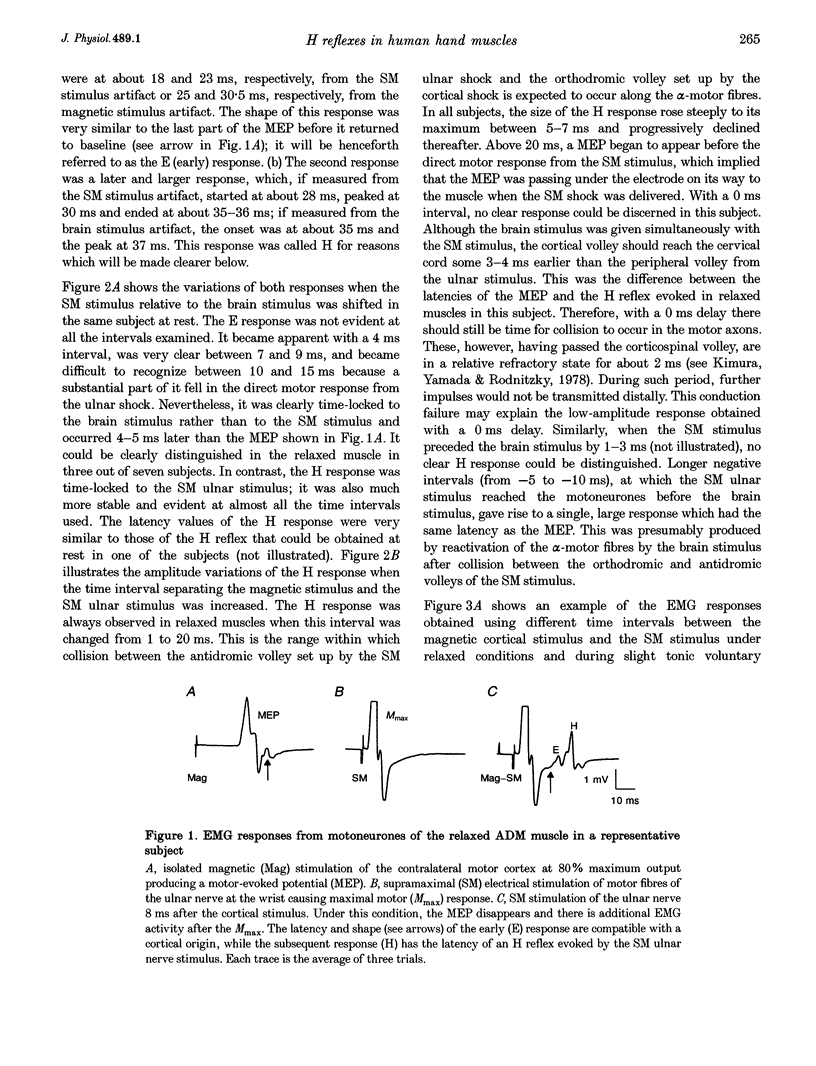
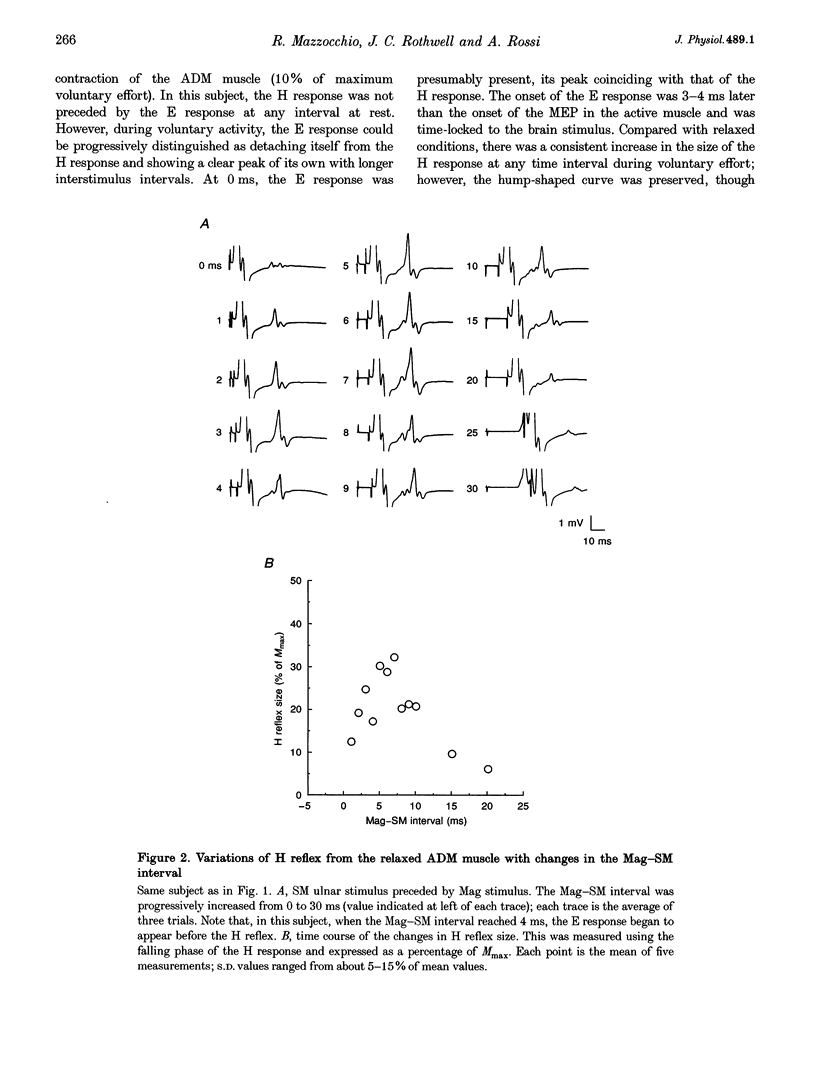

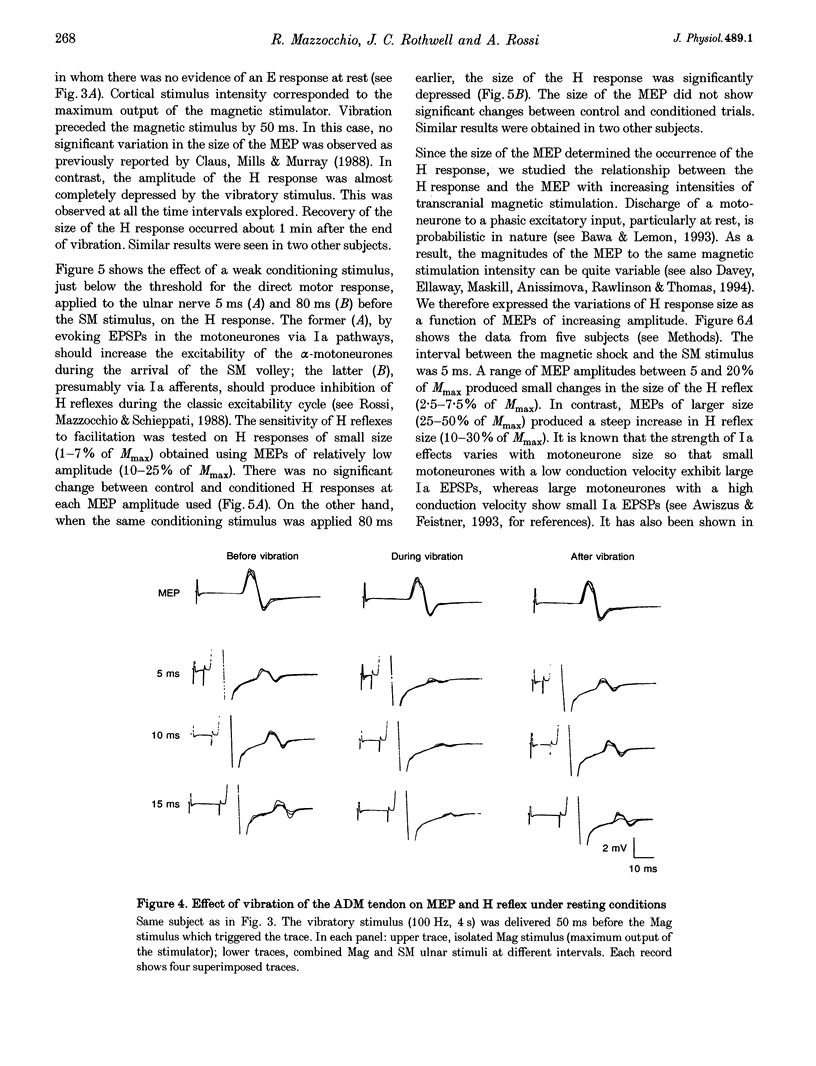

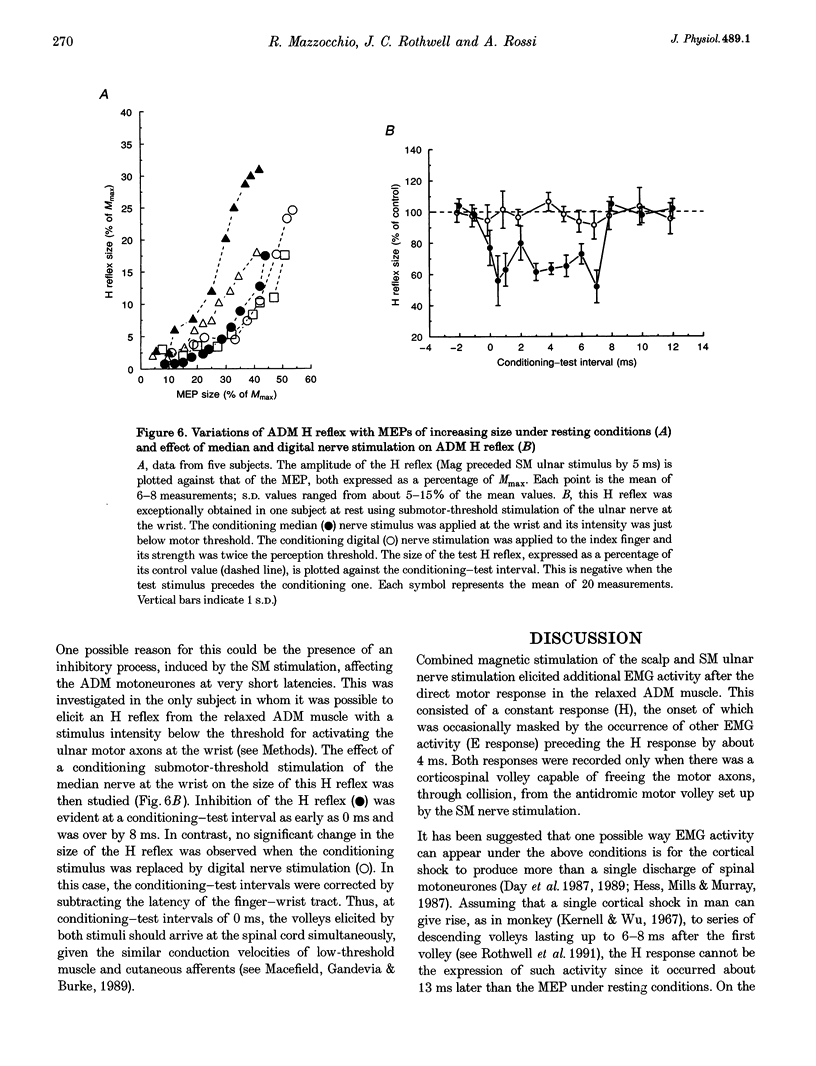
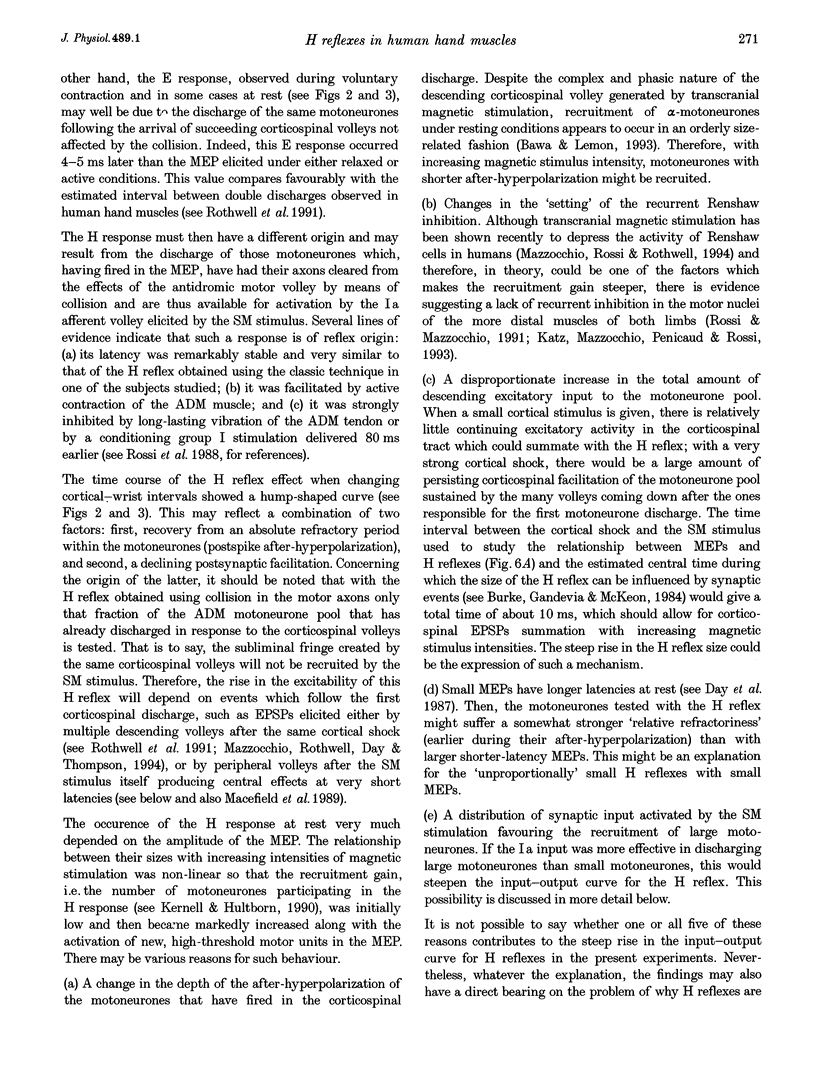


Selected References
These references are in PubMed. This may not be the complete list of references from this article.
- Awiszus F., Feistner H. The relationship between estimates of Ia-EPSP amplitude and conduction velocity in human soleus motoneurons. Exp Brain Res. 1993;95(2):365–370. doi: 10.1007/BF00229795. [DOI] [PubMed] [Google Scholar]
- Bawa P., Lemon R. N. Recruitment of motor units in response to transcranial magnetic stimulation in man. J Physiol. 1993 Nov;471:445–464. doi: 10.1113/jphysiol.1993.sp019909. [DOI] [PMC free article] [PubMed] [Google Scholar]
- Buller N. P., Garnett R., Stephens J. A. The reflex responses of single motor units in human hand muscles following muscle afferent stimulation. J Physiol. 1980 Jun;303:337–349. doi: 10.1113/jphysiol.1980.sp013289. [DOI] [PMC free article] [PubMed] [Google Scholar]
- Burke D., Gandevia S. C., McKeon B. Monosynaptic and oligosynaptic contributions to human ankle jerk and H-reflex. J Neurophysiol. 1984 Sep;52(3):435–448. doi: 10.1152/jn.1984.52.3.435. [DOI] [PubMed] [Google Scholar]
- Claus D., Mills K. R., Murray N. M. The influence of vibration on the excitability of alpha motoneurones. Electroencephalogr Clin Neurophysiol. 1988 May;69(5):431–436. doi: 10.1016/0013-4694(88)90065-x. [DOI] [PubMed] [Google Scholar]
- Clough J. F., Kernell D., Phillips C. G. The distribution of monosynaptic excitation from the pyramidal tract and from primary spindle afferents to motoneurones of the baboon's hand and forearm. J Physiol. 1968 Sep;198(1):145–166. doi: 10.1113/jphysiol.1968.sp008598. [DOI] [PMC free article] [PubMed] [Google Scholar]
- Collins W. F., 3rd, Honig M. G., Mendell L. M. Heterogeneity of group Ia synapses on homonymous alpha-motoneurons as revealed by high-frequency stimulation of Ia afferent fibers. J Neurophysiol. 1984 Nov;52(5):980–993. doi: 10.1152/jn.1984.52.5.980. [DOI] [PubMed] [Google Scholar]
- Davis B. M., Collins W. F., 3rd, Mendell L. M. Potentiation of transmission at Ia-motoneuron connections induced by repeated short bursts of afferent activity. J Neurophysiol. 1985 Dec;54(6):1541–1552. doi: 10.1152/jn.1985.54.6.1541. [DOI] [PubMed] [Google Scholar]
- Day B. L., Dressler D., Maertens de Noordhout A., Marsden C. D., Nakashima K., Rothwell J. C., Thompson P. D. Electric and magnetic stimulation of human motor cortex: surface EMG and single motor unit responses. J Physiol. 1989 May;412:449–473. doi: 10.1113/jphysiol.1989.sp017626. [DOI] [PMC free article] [PubMed] [Google Scholar]
- Day B. L., Rothwell J. C., Thompson P. D., Dick J. P., Cowan J. M., Berardelli A., Marsden C. D. Motor cortex stimulation in intact man. 2. Multiple descending volleys. Brain. 1987 Oct;110(Pt 5):1191–1209. doi: 10.1093/brain/110.5.1191. [DOI] [PubMed] [Google Scholar]
- Fritz N., Illert M., de la Motte S., Reeh P., Saggau P. Pattern of monosynaptic Ia connections in the cat forelimb. J Physiol. 1989 Dec;419:321–351. doi: 10.1113/jphysiol.1989.sp017875. [DOI] [PMC free article] [PubMed] [Google Scholar]
- Garnett R., Stephens J. A. Changes in the recruitment threshold of motor units produced by cutaneous stimulation in man. J Physiol. 1981 Feb;311:463–473. doi: 10.1113/jphysiol.1981.sp013598. [DOI] [PMC free article] [PubMed] [Google Scholar]
- HAGBARTH K. E. Post-tetanic potentiation of myotatic reflexes in man. J Neurol Neurosurg Psychiatry. 1962 Feb;25:1–10. doi: 10.1136/jnnp.25.1.1. [DOI] [PMC free article] [PubMed] [Google Scholar]
- Hess C. W., Mills K. R., Murray N. M. Responses in small hand muscles from magnetic stimulation of the human brain. J Physiol. 1987 Jul;388:397–419. doi: 10.1113/jphysiol.1987.sp016621. [DOI] [PMC free article] [PubMed] [Google Scholar]
- Kanda K., Desmedt J. E. Cutaneous facilitation of large motor units and motor control of human fingers in precision grip. Adv Neurol. 1983;39:253–261. [PubMed] [Google Scholar]
- Katz R., Mazzocchio R., Pénicaud A., Rossi A. Distribution of recurrent inhibition in the human upper limb. Acta Physiol Scand. 1993 Oct;149(2):183–198. doi: 10.1111/j.1748-1716.1993.tb09611.x. [DOI] [PubMed] [Google Scholar]
- Kernell D., Chien-Ping W. U. Responses of the pyramidal tract to stimulation of the baboon's motor cortex. J Physiol. 1967 Aug;191(3):653–672. doi: 10.1113/jphysiol.1967.sp008273. [DOI] [PMC free article] [PubMed] [Google Scholar]
- Kernell D., Hultborn H. Synaptic effects on recruitment gain: a mechanism of importance for the input-output relations of motoneurone pools? Brain Res. 1990 Jan 15;507(1):176–179. doi: 10.1016/0006-8993(90)90542-j. [DOI] [PubMed] [Google Scholar]
- Kimura J., Yamada T., Rodnitzky R. L. Refractory period of human motor nerve fibres. J Neurol Neurosurg Psychiatry. 1978 Sep;41(9):784–790. doi: 10.1136/jnnp.41.9.784. [DOI] [PMC free article] [PubMed] [Google Scholar]
- Macefield G., Gandevia S. C., Burke D. Conduction velocities of muscle and cutaneous afferents in the upper and lower limbs of human subjects. Brain. 1989 Dec;112(Pt 6):1519–1532. doi: 10.1093/brain/112.6.1519. [DOI] [PubMed] [Google Scholar]
- Maier M. A., Bennett K. M., Hepp-Reymond M. C., Lemon R. N. Contribution of the monkey corticomotoneuronal system to the control of force in precision grip. J Neurophysiol. 1993 Mar;69(3):772–785. doi: 10.1152/jn.1993.69.3.772. [DOI] [PubMed] [Google Scholar]
- Marsden C. D., Merton P. A., Morton H. B. Stretch reflex and servo action in a variety of human muscles. J Physiol. 1976 Jul;259(2):531–560. doi: 10.1113/jphysiol.1976.sp011481. [DOI] [PMC free article] [PubMed] [Google Scholar]
- Masakado Y., Kamen G., De Luca C. J. Effects of percutaneous stimulation on motor unit firing behavior in man. Exp Brain Res. 1991;86(2):426–432. doi: 10.1007/BF00228968. [DOI] [PubMed] [Google Scholar]
- Mazzocchio R., Rossi A., Rothwell J. C. Depression of Renshaw recurrent inhibition by activation of corticospinal fibres in human upper and lower limb. J Physiol. 1994 Dec 1;481(Pt 2):487–498. doi: 10.1113/jphysiol.1994.sp020457. [DOI] [PMC free article] [PubMed] [Google Scholar]
- Mazzocchio R., Rothwell J. C., Day B. L., Thompson P. D. Effect of tonic voluntary activity on the excitability of human motor cortex. J Physiol. 1994 Jan 15;474(2):261–267. doi: 10.1113/jphysiol.1994.sp020018. [DOI] [PMC free article] [PubMed] [Google Scholar]
- Rossi A., Mazzocchio R. Presence of homonymous recurrent inhibition in motoneurones supplying different lower limb muscles in humans. Exp Brain Res. 1991;84(2):367–373. doi: 10.1007/BF00231458. [DOI] [PubMed] [Google Scholar]
- Rossi A., Mazzocchio R., Schieppati M. The H reflex recovery curve reinvestigated: low-intensity conditioning stimulation and nerve compression disclose differential effects of presumed group Ia fibres in man. Hum Neurobiol. 1988;6(4):281–288. [PubMed] [Google Scholar]
- Rothwell J. C., Thompson P. D., Day B. L., Boyd S., Marsden C. D. Stimulation of the human motor cortex through the scalp. Exp Physiol. 1991 Mar;76(2):159–200. doi: 10.1113/expphysiol.1991.sp003485. [DOI] [PubMed] [Google Scholar]
- Schieppati M. The Hoffmann reflex: a means of assessing spinal reflex excitability and its descending control in man. Prog Neurobiol. 1987;28(4):345–376. doi: 10.1016/0301-0082(87)90007-4. [DOI] [PubMed] [Google Scholar]
- Stanley E. F. Reflexes evoked in human thenar muscles during voluntary activity and their conduction pathways. J Neurol Neurosurg Psychiatry. 1978 Nov;41(11):1016–1023. doi: 10.1136/jnnp.41.11.1016. [DOI] [PMC free article] [PubMed] [Google Scholar]
- Upton A. R., McComas A. J., Sica R. E. Potentiation of "late" responses evoked in muscles during effort. J Neurol Neurosurg Psychiatry. 1971 Dec;34(6):699–711. doi: 10.1136/jnnp.34.6.699. [DOI] [PMC free article] [PubMed] [Google Scholar]


